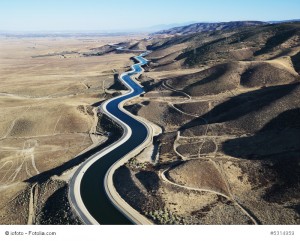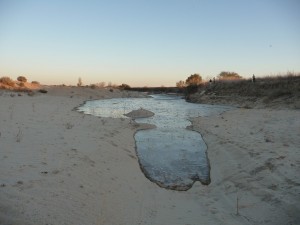
Of all the mythologies that dominate San Joaquin Valley politics, the mythology of water may be the most powerful and enduring. The basis of the myth consists of a simple fiction that states, unequivocally, that all valley water is, “our water.”
Grammarians, of whom there are fewer and fewer, might ask who is meant by “our,” but such a question would be grossly out of order in a region where the residents virtually uniformly believe “our” means “my.” If there were such things as careful consideration and critical thinking involved in the discussion (not to mention grammar), the errors in this confusion of pronouns wouldn’t just reveal trivial concerns, but instead a really big lie.
Thus, when California state government attempts to have a say in the allocation of water from valley rivers, valley citizens rise as one, screaming in unison, “Water Grab!” The trick here, as in many tricks, lies in a simple act of misdirection.
Yes, there is a water grab, but it’s not the state that’s grabbing the water, it’s valley farmers—and who better to promote an enduring myth than those same farmers, whose long history of storytelling includes the tale of the struggling family whose daily toil with tractor, hoe, and shovel keeps food on our tables?
Even with the evidence of our eyes, we’re still prone to overlook the hundreds of miles of nut trees everywhere in favor of believing most valley farmers are hard at work growing the foods people actually eat—the tomatoes, leafy greens, beans, peas, carrots, and other vegetables. These crops have in fact most recently been tossed aside in favor of almonds and pistachios, the vast bulk of which are exported. The inevitable result is a rise in prices of foods most of us really do put on our tables.
Here are a couple of facts about farmers and water: (1) Farmers use by far the most water of any business in California (here’s where to look for the clearest explanation of water use in California), and (2) agriculture produces only about 2% of California’s gross domestic product. Anyone who looks at the San Joaquin or Tuolumne Rivers in an average year will see they almost always run low, especially in summer. In fact, for decades, the San Joaquin River ran dry every year for a length of sixty miles, strictly because of water diversions by farmers.
Los Angeles’ Stuart Resnick is by far the nation’s most successful nut farmer. He owns at least 180,000 acres of farmland, most of it in the southern San Joaquin Valley, and virtually monopolizes the domestic pistachio business. Resnick alone uses over 400,000 acre feet of water a year; compare that figure to the 587,000 acre feet per year consumed by the entire city of Los Angeles.
Some might wonder how Resnick manages to acquire so much water every year in a region as arid and desert-like as the southern San Joaquin Valley. The answer is propaganda and politics. In fact, politics is the magic act by which “our water” becomes “their water.”
Once farmers had used up virtually all the available water in the southern San Joaquin Valley—that is, once they had drained the largest lake west of the Mississippi and diverted almost all the water from valley rivers, and once they had pumped all the groundwater from one of the last of the nation’s great aquifers—they looked north for so-called “surplus water.” Ever since, at great public expense and to the detriment of fisheries, recreational values, and the ecology of the San Joaquin Delta and San Francisco Bay, farmers in the south have been buying water from the north at bargain rates. “Our water” became their water, and they’ve made enormous fortunes with it.

But even here in the northern San Joaquin Valley the big lie about water gets spread with virtually no opposition. Consider Stanislaus County Supervisor Jim DeMartini’s recent “State of the County” speech last Tuesday.
During his speech, DeMartini made the bizarre claim that water stored behind dams belongs to the entities that built the dams:
“No state or federal money went into the construction of the Don Pedro and Exchequer dams,” he proclaimed. “These dams are owned by the ratepayers of the irrigation districts. Yet the State Water Resources Control Board wants to take the water stored behind those facilities that we own, and use it for their purpose.”
DeMartini conveniently left out the historical fact that O’Shaughnessy Dam, completed in 1923, lies above Don Pedro Dam and was paid for by the city of San Francisco. By DeMartini’s logic, the Tuolumne River water stored behind O’Shaughnessy Dam should all belong to the city of San Francisco. In fact, San Francisco diverts about 14 percent of the Tuolumne River’s total flow.
DeMartini also manages to leave out what is likely the most overlooked fact about water in the valley and that is the reality that much of “our” river and reservoir water is pumped into farmers’ fields and orchards via groundwater. Hydrologists tell us that groundwater is for the most part produced by flows from rivers, lakes, and reservoirs. Thus, when you see a body of water such as Modesto Reservoir surrounded by almond orchards, you can be assured that much of the water for those orchards comes from the reservoir itself, which supposedly belongs to the City of Modesto.
The obvious reason valley farmers and most residents fear any reduction in water for agriculture is economics. Agriculture is by far the valley’s most powerful economic engine, and so dominant that few valley citizens ever think about how few ag dollars actually trickle down to the broader populace.
Known as the Appalachia of the West, the San Joaquin Valley is one of the poorest regions in the United States. Many believe that much of the poverty is due to what they call a “Plantation Economy,” an economy that disproportionately concentrates wealth into a small percentage of the population.
Farmers have long realized the source of wealth in the Valley is water and have thus virtually monopolized the use of a public resource. This appropriation of a public resource for private gain is almost never questioned, mostly because farmers and their friends are superb propagandists. Yes, it’s “our” water, but why is it so few of us share in its bounty?

very well written. Nice to have a somewhat unbiased approach to news, taking in the history of the issue as well. I do wonder if these big farm folks spread a little of their wealth around- by employing some folks (even immigrants) and are any of them more focused on community vs. themselves? And, there are still many small farms in this area too- that struggle- I know of a few of the owners of the small farms- that make a meager profit that is ‘just above the poverty level’…are they worthy of ‘saving our water’?
Agreed; Very well written but devoid of constructive alternatives. There is plenty of water for everyone if it is conserved and utilized rationally. Billions of acre feet flow needlessly into SF Bay through the Carquinez Strait instead of being utilized by a strategically located dam allowing the Central Valley aquifer to be recharged as a direct result.
For some strange reason, the people of California waste the storm water that comes annually instead of capturing and storing it for the inevitable dry season each year as do other areas of the world with similar conditions. For some strange reason, it is preferable to fix blame than to address the problem, itself.
Water flowing into the San Francisco Bay from the San Joaquin Delta is critical to the ecology of both the bay and the delta. Dams have been show to be destructive to fisheries, among other negative consequences. It would be interesting to see the evidence showing how a “strategically located dam” would recharge the San Joaquin aquifer. Kind of hard to picture that image.
Great article! This is why counties dominated by agriculture look like third world countries compared to those with more diversified economies
Excellent. More needs to be revealed re. who buys land for Resnick, the truth about Trinitas and some informed prognosis about the future of water in our area.
DeMartini and the troops did their damage by approving more than 480 Ag well permits during the drought which resulted in “hurt” to families and our aquifer. So many more “lies”.
I would need a week to dispel have the nonsense written here. Eric Caine obviously knows little about farming
I wasnt aware that the County Board of Supervisors approved wells. Did DeMartini vote to alprove 480 wells?
I offer some constructive alternatives, but you likely need to change some perspectives to get it. Please see my initial blog post, Water Storage & Water Available for Replenishment/ Recharge: A Promising Marriage
http://rainfalltogroundwater.net/2018/01/26/water-storage-water-available-for-replenishment/ and the new website itself for more info.
Netflix has an intriguing documentary on this subject: Water & Power: A California Heist.
Resnick’s activities with farming and water is featured. I highly recommend watching but do so with some chamomile tea; it’ll increase your blood pressure!